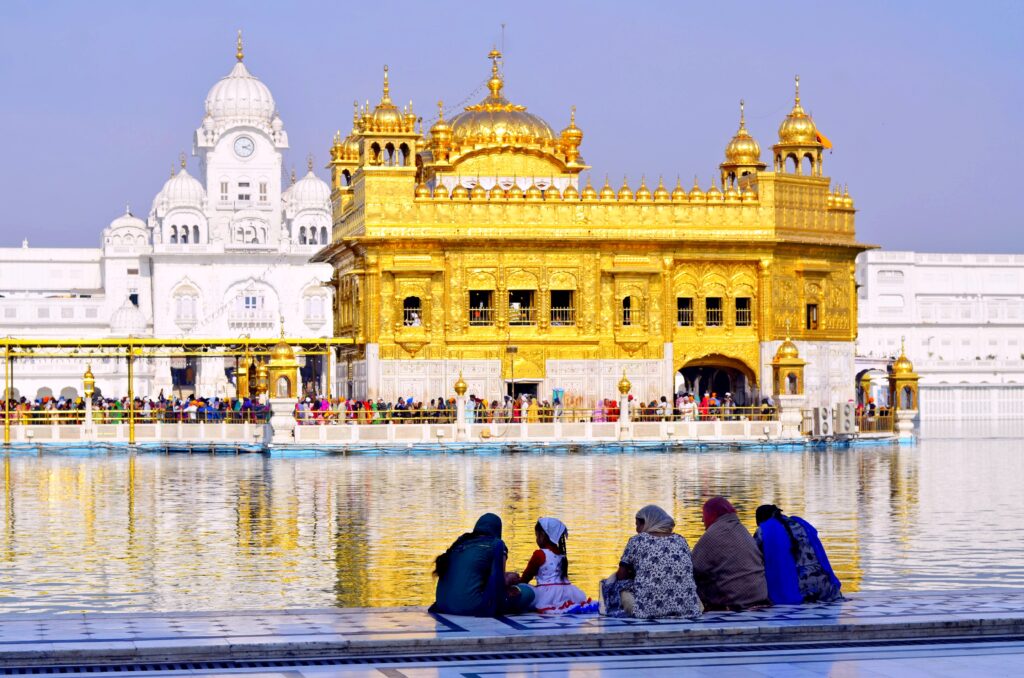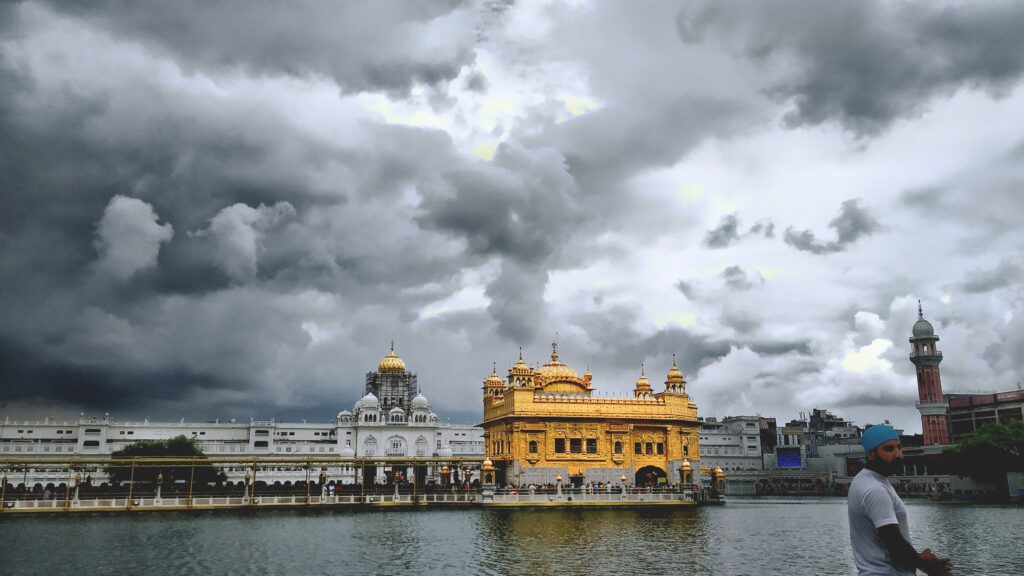The Golden Temple, also known as Sri Harmandir Sahib, is one of the most breathtaking architectural marvels in the world. Located in Amritsar, Punjab, India, it serves as the spiritual and cultural center for Sikhism. Adorned with gleaming gold and intricately designed details, this sacred place attracts millions of visitors each year who come to witness its beauty, seek spiritual solace, and experience the rich Sikh heritage.

The history of the Golden Temple dates back to the 16th century when Guru Nanak Dev Ji, the first Sikh Guru, visited the area. Initially, there was a small pool surrounded by a humble shelter, which later evolved into the magnificent structure we see today. Guru Ram Das, the fourth Sikh Guru, envisioned a grand temple and started the construction work. The temple was further expanded and embellished by his successor, Guru Arjan Dev Ji, and subsequent Sikh leaders.
Shimmering in the sunlight, the Golden Temple is truly a sight to behold. The complex consists of four entrances, symbolizing the inclusivity of Sikhism and its open embrace of all people regardless of their background or beliefs. As you approach the temple, you are greeted by the stunning expanse of the Amrit Sarovar, a holy water tank that surrounds the temple, creating a serene and tranquil atmosphere.

The architecture of the Golden Temple is a fusion of various influences, including Sikh, Mughal, and Rajput styles. The temple’s construction materials include marble, granite, and gold leaf, which give it its golden appearance. The four-story structure stands tall in the middle of the pool, supported by a marble platform. The main building is crowned by a gilded dome, also known as the “Gagan Mandir” or “Hari Mandir,” which represents the divine presence of the Sikh Gurus.
The intricate detailing on the temple’s exterior is a true testament to the craftsmanship of Sikh artisans. The walls are adorned with beautiful frescoes, showcasing scenes from Sikh history, including the battles fought by Guru Gobind Singh Ji, the tenth Sikh Guru. These intricate artworks, known as “Pietra dura,” are made with precious stones and reflect the rich artistic tradition of the region.

Stepping inside the Golden Temple, visitors are greeted by a sense of tranquility and spirituality. The marble floors are covered with intricate patterns, and the walls are adorned with delicate frescoes and inlays. A remarkable feature of the temple is the continuous recitation of the Guru Granth Sahib, the holy scripture of Sikhism, which can be heard throughout the complex. This meditative hymn singing, known as “Kirtan,” adds to the ambiance of the temple, creating an atmosphere of devotion and peace.
One of the most remarkable aspects of the Golden Temple is the Langar, or community kitchen, which serves free vegetarian meals to anyone who visits. This tradition reflects the Sikh principles of equality and service to humanity. People from all walks of life, irrespective of their social status or religious background, come together to share a meal as equals, seated in long rows on the floor. It’s a humbling experience that highlights the spirit of compassion and unity that is integral to Sikhism.
More: Wanted to download Odishashop, visit here
Another architectural marvel within the complex is the Akal Takht, the highest seat of authority for the Sikh community. The Akal Takht, meaning “Throne of the Timeless One,” represents the temporal aspect of Sikhism. Built in 1606 by Guru Hargobind Sahib, the sixth Sikh Guru, it was originally intended as a place for the Guru to address matters of religion and state. Today, it continues to serve as a symbol of Sikh sovereignty and a platform for discussing important community issues.
Beyond its architectural splendor, the Golden Temple holds deep spiritual significance for Sikhs and is a place of pilgrimage for followers of the faith from all over the world. The temple is believed to house the “Adi Granth,” the sacred scripture and embodiment of the Sikh Gurus. It serves as the spiritual center where Sikhs can connect with their Gurus and seek their guidance.
Visiting the Golden Temple is a sensory experience that goes beyond the visual awe inspired by its architecture. As you approach the temple, you’re enveloped by the soothing sounds of Kirtan, the sweet fragrance of incense, and the warmth of devotion that permeates the air. The sense of community and camaraderie among the visitors is palpable, creating an atmosphere of unity and shared spirituality.

In conclusion, the Golden Temple in Amritsar stands out as a true marvel of architectural brilliance. The meticulous detailing, the awe-inspiring gold leaf, and the spiritual significance it holds make it a must-visit destination for anyone seeking a glimpse into the rich Sikh heritage and a moment of quiet introspection. Whether you are a Sikh or not, the beauty and serenity of the Golden Temple will leave an indelible mark on your soul.
FAQ For The Stunning Architecture of the Golden Temple in Amritsar
What is the Golden Temple in Amritsar?
The Golden Temple, also known as Sri Harmandir Sahib, is a famous Sikh gurdwara (place of worship) located in Amritsar, Punjab, India. It is considered one of the most iconic and holiest Sikh shrines in the world.
Why is it called the Golden Temple?
The main reason for its name is the stunning golden exterior that adorns the temple. The temple is covered in gold plating that gives it a radiant, shimmering appearance, especially when illuminated by natural sunlight.
What is the architectural style of the Golden Temple?
The Golden Temple showcases a unique blend of architectural styles. It predominantly features a magnificent blend of Sikh and Mughal architectural elements. The complex includes various buildings, courtyards, and a central pool, all of which are designed with meticulous attention to detail.
What makes the architecture of the Golden Temple special?
The architecture of the Golden Temple exhibits several remarkable features. The most prominent is the gold-plated exterior, which instantly catches the eye and creates a captivating scene. The temple’s four entrances symbolize the universal acceptance and openness of the Sikh faith. Additionally, the temple’s central dome, adorned with intricate goldwork, stands as a symbol of Sikh spiritual and cultural heritage.
Are there any other noteworthy architectural elements within the temple complex?
Indeed, several architectural elements within the Golden Temple complex are worth mentioning. The Darshani Deori, which means “gates of vision,” is an impressive entrance adorned with intricate carvings. The stunning mirrored work on the walls and ceilings of the upper level Hall of Gurudwara adds to the overall beauty. Moreover, the floating walkway, known as the Guru’s Bridge, connects the entrance to the central sanctum and offers a serene view of the temple.
Can visitors access the Golden Temple and explore its architecture?
Yes, the Golden Temple is open to visitors from all religions and walks of life. Visitors are required to cover their heads, remove their shoes, and wash their feet before entering the temple premises. There is no entry fee, and the stunning architectural marvels within the complex can be freely explored.
Is photography allowed within the Golden Temple complex?
Yes, photography is allowed within the Golden Temple complex. Visitors can capture the awe-inspiring architectural beauty, as long as they are respectful and mindful of others’ religious sentiments.

